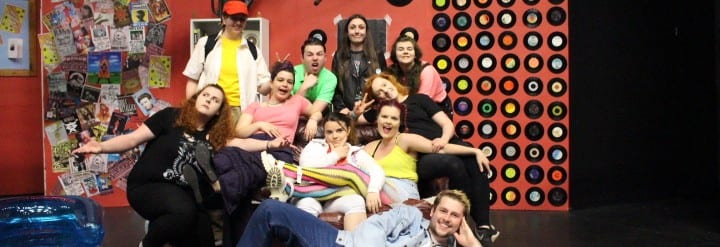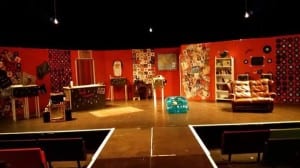The first time we were allowed into the performance space to set up the flats that we would be using as to create a fully realistic experience for the audience as we were doing a farce, “it wasn’t a comedy set” (16). Originally I only wanted two entrances and exits, one being the auditorium door, the other being a door frame behind the counter which would lead up to the apartment. Upon setting up the flats it was discovered that there were two flats with door frames and one member of the tech team suggested creating a store-room which could be used as another entrance and exit. We developed this into the story to be used for comedic effect throughout the piece. By creating the stock room it gave the set further depth and interesting structure for the character interactions.
We decided not to use doors within the frames, removing boundaries between each theoretical location and producing a decrepit feeling within the store. To create a soft boundary between the theoretical flat and the record store I decided upon door beads which further hinted at the 80’s culture still existing within the store.

First look at the flats used within the show – before repaint (Kick a Pigeon Theatre, 2017)
When we originally saw the flats in the setup to be the record store, I realized the original color was lackluster and did not suit the feel which we wanted for the record store. My first thought was to paint the flats black, but it was realized that this would enclose the space and the decorations for the flats would not stand out. The tech team suggested using red as this would match the 80’s/90’s theme and allow the decorations to stand out. We decided to utilize the notice board on one of the flats as a visual gag for the audience throughout the performance but also as a prop within the story-line. For example, Alex using it to place her band posters on and a place for Daisy to put a reminisce of her dead boyfriend which was referred too towards the end of the piece.
Through looking at record stores that still exist today, I decided to have two of the flats decorated with vinyls and another flat decorated with the sleeves of the vinyls. From the very beginning I knew I wanted a ‘poster wall’ which would be made up of rave, music and film posters from the time, that pre-dated 1997. As the basis of the set was done, I started adding more personal touches to it so to add to the ‘homely’ aesthetic. I carried on researching popular items in the 90’s to add more references to the time around the set, this included ordering trolls which were placed around and glow-in the dark stars to make it appear as if Daisy, the owner of the record store, tried to ‘brighten’ the store up and make it more up to date.
Works Cited
Kick a Pigeon Theatre (2017) Record ’97. [image] Lincoln Performing Arts Centre: Kick a Pigeon Theatre.

